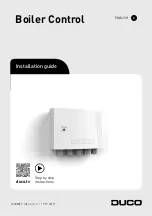
14
WARNING
• INSTALL BOILER SO THAT THE GAS IGNITION SYSTEM COMPONENTS ARE
PROTECTED FROM WATER (DRIPPING, SPRAYING, RAIN, ETC.) DURING
APPLIANCE OPERATION AND SERVICE (CIRCULATOR REPLACEMENT, ETC.).
• OPERATION OF THIS BOILER WITH CONTINUOUS RETURN TEMPERATURES
BELOW 120°F CAN CAUSE SEVERE HEAT EXCHANGER CORROSION DAMAGE.
• OPERATION OF THIS BOILER IN A SYSTEM HAVING SIGNIFICANT AMOUNTS OF
DISSOLVED OXYGEN CAN CAUSE SEVERE HEAT EXCHANGER CORROSION
DAMAGE.
• DO NOT USE TOXIC ADDITIVES, SUCH AS AUTOMOTIVE ANTIFREEZE, IN A
HYDRONIC SYSTEM.
• PIPE RELIEF VALVE DISCHARGE TO A SAFE LOCATION. THE RELIEF VALVE
MAY DISCHARGE SCALDING HOT WATER.
• DO NOT INSTALL A VALVE IN THE RELIEF VALVE DISCHARGE LINE.
• DO NOT MOVE RELIEF VALVE FROM FACTORY LOCATION.
• DO NOT PLUG RELIEF VALVE DISCHARGE. BLOCKING THE RELIEF VALVE MAY
RESULT IN BOILER EXPLOSION.
VIII System Piping
Standard Piping
Figure 8.3 shows typical boiler system connections on a single zone system. Additional information on hydronic system
design may be found in the
I=B=R
Guide RHH published by the Air-Conditioning, Heating and Refrigeration Institute
(AHRI). The components in this system and their purposes are as follows:
1) Relief valve (Required) - Mount the relief valve on the left side of the boiler as shown in Figure 8.1 using the 1-1/4 x 4
nipple, 1-1/4 x 3/4 reducing elbow and 3/4 x close nipple provided. The relief valve shipped with the boiler is set to open
at 30 psi. This valve may be replaced with one having a pressure up to the “Maximum Allowable Working Pressure”
shown on the rating plate. If the valve is replaced, the replacement must have a relief capacity in excess of the DOE
heating capacity for the boiler.
Pipe the discharge of the relief valve to a location where water or steam will not create a hazard or cause property damage
if the valve opens. The end of the discharge pipe must terminate in an unthreaded pipe. If the relief valve discharge is
not piped to a drain it must terminate at least 6 inches above the floor. Do not run relief valve discharge piping through an
area that is prone to freezing. The termination of the relief valve discharge piping must be in an area where it is not likely
to become plugged by debris.
If necessary, the relief valve may be installed in the supply piping as shown in Figure 8.2. When this is done, the relief
valve must be as close to the boiler supply tapping as possible with no intervening shut-off valves.
2) Circulator (Required) - The circulator is shipped loose with the boiler. Fittings are provided to mount it on the boiler
return as shown in Figure 8.3, however it can be installed on the boiler supply. If the circulator is moved to the supply it
should be positioned just downstream of the expansion tank as shown in Figure 8.3.
3) Expansion Tank (Required) - If this boiler is replacing an existing boiler with no other changes in the system, the
old expansion tank can generally be reused. If the expansion tank must be replaced, consult the expansion tank
manufacturer’s literature for proper sizing.
4) Fill Valve (Required) - Either a manual or automatic fill valve may be used. The ideal location for the fill is at the
expansion tank.
Summary of Contents for AWR Series
Page 2: ......
Page 23: ...21 FIGURE 9 0 LINE VOLTAGE FIELD CONNECTIONS FIGURE 9 1 LOW VOLTAGE FIELD CONNECTIONS...
Page 24: ...22 FIGURE 9 2 INTERNAL CONNECTIONS DIAGRAM...
Page 25: ...23 FIGURE 9 3 LADDER DIAGRAM...
Page 43: ...41 Notes...
Page 45: ...43...
Page 47: ...45...
















































